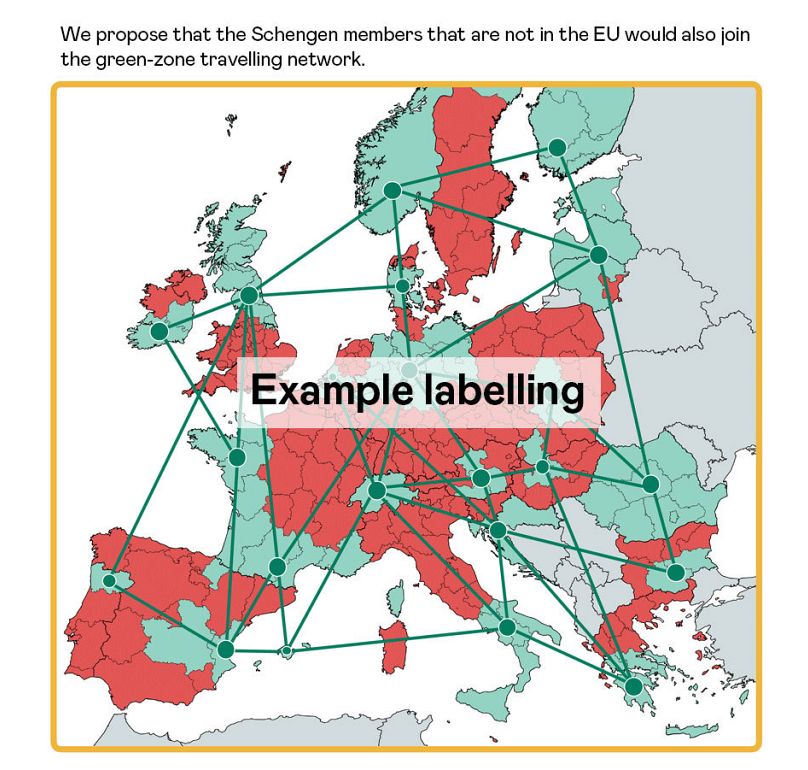Madrid's Esade Business School has come up with a simple plan to rescue Europe's summer holiday season. But, will it work?
With many countries now easing their COVID-19 lockdowns, Europeans are re-emerging with the same two questions: Can we go on holiday this summer? And, if so, where?
The fear among governments, though, will be that the increased movement of people will spark a fresh wave of infections.
But one study from Spain thinks it's found a solution.
It wants the whole of Europe to plot its worst (red zones) and least (green zones) COVID-19-affected regions and for people to travel accordingly.
'Green zones' of different European countries
A policy proposal by Madrid's Esade Business School wants to "elevate the green zoning approach to the level of the European Union".
"The idea is simple: allowing the mobility of people between "green zones" of different European countries through a network of regions certified by European institutions," the study reads.
The system would allow, for instance, travel between southern Italy and southern France, or between Greece and Switzerland: as long as you come from a European green-zone, you would be allowed to travel to another.
National green-zones "are very good candidates for obtaining the green label from the EU," researcher Miquel Oliu Barton, who co-authored of the study, explained to Euronews' Marta Rodriguez Martinez.
To obtain the green label, Oliu Barton said, a region should prove that the virus is under control: that the region's hospitals are not saturated, that the growth rate of new infections is low and that tests are generalised.
The researcher suggested that highway exits could remain closed in red areas.
"The same should apply to the train: coming from green areas, it should not stop at 'red' stations," he added. "And at airports, it's relatively easy to control where someone is coming from and where they want to go."
Another measure the study proposes is for travellers to present a residence permit as proof that they come from a green-zone.
'Save the summer tourist season'
Even though the COVID-19 outbreak is easing in some countries, the prospect of a normal summer holiday this year is looking uncertain for many.
In several EU countries, borders are shut — allowing people to cross only if they have an important reason —, travel restrictions have been introduced and international travel is discouraged.
This year will not be good for the global travel industry, which is expecting losses of between 20 and 30 per cent, according to estimates by the World Tourism Organization (UNWTO).
"Such travel restrictions will additionally damage the already weakened economies of Europe’s southern countries, such as Spain or Italy, because they rely on tourism more heavily than the northern countries," the study notes.
But as countries start to reopen their borders, this policy might be the way forward to "save the summer tourism season in southern Europe", the authors of the study said:
"If well communicated and with sufficient guarantees, this proposal could save the summer tourist season in southern Europe, thus mitigating the enormous economic costs that the closure to international tourism could cause for these countries."
Oliu Barton said that the proposal was sent to the bloc on 5 May and "has been highly appreciated so far". "If adopted, the first European green areas could arrive very soon, as early as June," he added.
On Wednesday, the European Commission outlined its plan for a gradual and coordinated lifting of travel restrictions and border controls across the EU. It proposes an approach that "starts by lifting restrictions between areas or Member States with sufficiently similar epidemiological situations".
That would imply that residents of countries with similar levels of infections should be able to travel more freely to and from those countries.
But European Commissioner for Home Affairs Ylva Johansson insisted that member states cannot discriminate between EU passports.
"If a border is opened, then all EU nationals can pass through that border," she told Euronews.
Baltic countries Lithuania, Estonia and Latvia are already on course to reopen their borders to each other from Friday (May 15) after having so far avoided the worst of the coronavirus pandemic.
France has said it will keep borders shut until "at least 15 June" and will reassess closer to the date.
Austria said its border with Germany would reopen fully on June 15. Chancellor Sebastian Kurz said Austria was aiming for similar agreements with Switzerland, Liechtenstein and its eastern neighbours` "as long as the infection figures allow."
Find out more about Austria's plans by watching Nial O'Reilly's report in the video player above.












